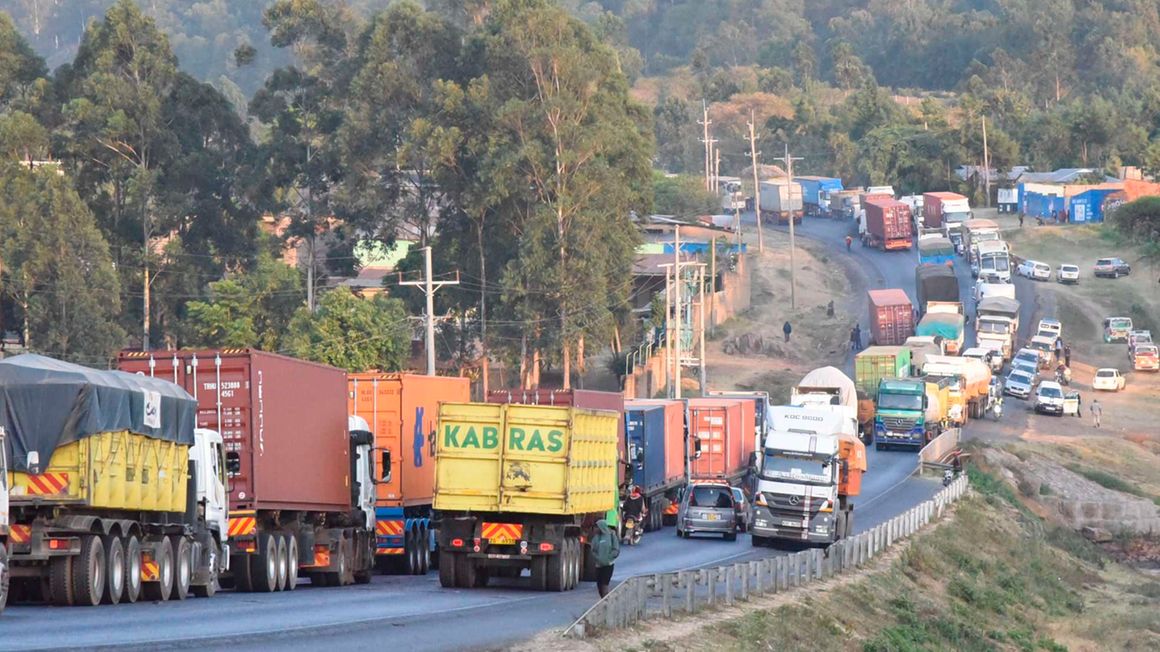
Trucks transporting goods to Uganda held up in a traffic jam on the Eldoret-Webuye highway. FILE PHOTO | NMG
Weeks after President William Ruto moved to implement his poll pledge to return port services to Mombasa, his directive turned out to be a double-edged sword.
By the end of last week, business operators along the Mombasa-Nairobi highway started recording a significant recovery in fortunes as more trucks got back on the road. Truckers had lost out as the government prioritised the standard gauge railway (SGR) in hauling cargo destined for Nairobi and other hinterlands.
But as truckers record their wins, analysts warn of the unintended negative effects on the environment.
With about 300 trucks amongexpected to return to the highway, the move will expose Kenya to increased road damage, accident and pollution despite making strides in reducing emissions.
Northern Corridor Transit and Transport Coordinating Authority (NCTTCA) executive secretary Omae Nyarandi said he supports the move by Dr Ruto to allow traders to make a choice on the mode of transport, but it comes with a cost.
Eco-friendly driving“NCTTCA supports eco-friendly driving and it has intensified campaigns to train and create awareness to truck drivers along the corridor. The authority has also activated the use of roadside stations (RSS) along the highway, with a private firm partnering with the government to construct such a station at Gilgil along the Nairobi-Nakuru highway,” said Mr Nyarandi.
“We are pushing to have RSS, especially this time when most of the trucks have returned on our roads so as to reduce accidents which are attributed to fatigue.”
The latest data from the National Transport and Safety Authority (NTSA) show that Mombasa Road is the leading killer road in Kenya, with the number of reported deaths on the highway rising to 2,294 this year from 2,084 last year.
Mr Nyarandi said the authority will in the coming weeks enhance its training of truck drivers on eco-driving to improve road safety and preserve the environment. He warned that the country should expect to spend more on maintaining damaged roads and dealing with lost man hours caused by traffic jams.
Various studies estimate that Kenya loses between Sh50 million and Sh100 million annually to traffic jams, which translates to more than Sh18 billion a year.
Eco-driving has become an integral part of transport sector emissions reduction strategies in several countries. It helps minimise drivers' stress, improve driving comfort, reduce vehicle parts wear and tear or maintenance, improve travel time and reduce the number of road traffic accidents.
The authority has also activated the use of RSS facilities along the highway with a private firm partnering with the government to construct such a station at Gilgil along the Nairobi-Nakuru highway, in addition to other gazetted rest centres.
Last year, the Kenya Revenue Authority (KRA) and Northern Corridor stakeholders inspected roadside stations for certification, which is aimed at decongesting and reducing accidents.
RSS programme
The RSS programme, which also seeks to identify safe places for cargo crew, was launched in 2015 and has so far identified 141 roadside sites in the East Africa Community member states.
Out of these stations, 67 are a priority and will be geo-fenced to ensure cargo loss is minimised while drivers get a proper place to rest after stipulated working hours.
Increased trucks are expected to increase pollution, which has been a problem in Kenya. Data from the State of the Global Air report of 2020 indicate that in 2020 alone, air pollution was responsible for around 5,000 premature deaths in the country, with up to a third of the country’s population suffering from respiratory ailments exacerbated by poor air quality.
More business
Shippers Council of East Africa (SCEA) executive officer Gilbert Lagat said cargo owners are the top beneficiaries as they will enjoy door-to-door delivery, competitive prices and more storage time at container freight stations (CFSs) whereas truck owners will have more businesses along the corridor.
On the other hand, Kenya should expect more truck traffic, increased road damages and pollution as between additional 300 and 600 trucks per day are expected along Northern Corridor.
“With all the benefits, Kenya Railways Corporation (KRC) is set to experience reduced business from the current 40 percent to about 10 percent, which will negatively impact on government’s revenue for loan payment granted for the construction of the SGR,” said Mr Lagat.
→ akitimo@ke.nationmedia.com

No comments:
Post a Comment